The Amagezi Education Centre (AEC) was built in 2006 predominantly thanks to funding from a group of student volunteers from Leeds University. It shares a compound with a sister charity called Soft Power Health who run a health clinic alongside many other projects. Made up of several blocks, the AEC creates a little oasis with hedge lined paths that connect the different buildings. The main building sits furthest from the entrance and is home to the drama theatre, computer suite and an exhibition that shows the history of the charity and its continued growth over the past 15 years.
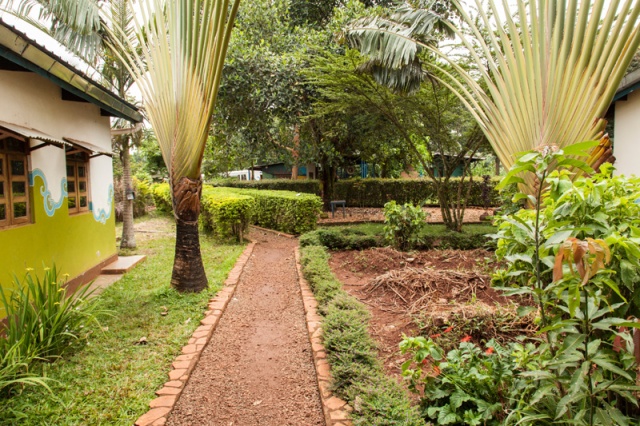 SPE partners with 15 Government Primary Schools from across the Jinja District. Each year more than 2500 children in the P6 yeargroup – the penultimate class of primary school and usually 11 years old, but sometimes older, attend the centre. Each pupil comes to the centre twice in the academic year and spends a half day in each of the four departments of Art, Drama, ICT and Library. The lessons in each of the departments focus on life skills, such as food nutrition, family planning, malaria awareness and computer skills. The children further enjoy some sessions in Agriculture and Science taught as outreach sessions at their school.
SPE partners with 15 Government Primary Schools from across the Jinja District. Each year more than 2500 children in the P6 yeargroup – the penultimate class of primary school and usually 11 years old, but sometimes older, attend the centre. Each pupil comes to the centre twice in the academic year and spends a half day in each of the four departments of Art, Drama, ICT and Library. The lessons in each of the departments focus on life skills, such as food nutrition, family planning, malaria awareness and computer skills. The children further enjoy some sessions in Agriculture and Science taught as outreach sessions at their school.
As we start to tour the centre we meet Daniel. He is actually a member of the Special Needs Project, which is currently temporarily operating in a small space at the AEC. This project will soon move into the new building at KCC. The Special Needs Project offers basic education to children, who are often rejected from mainstream schooling, in two different locations. The children who attend the education clinics are a wide range of ages and disabilities. Sula, the oldest here today at 17, has just been on a work placement with the School Refurbishment Project of Soft Power Education helping out at one of the current building projects. SPE sees it as important to help these kids learn practical skills to help them contribute to society and to their families.
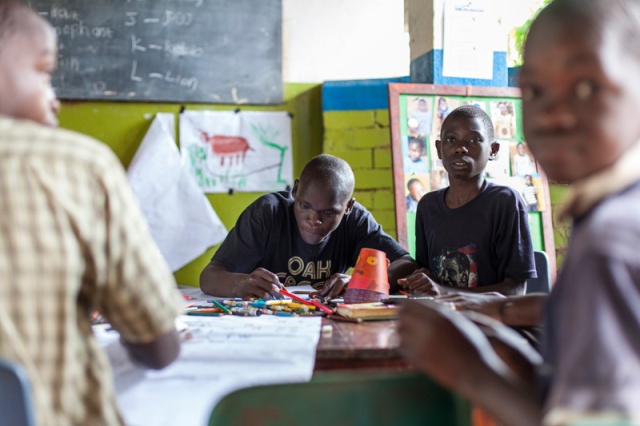 SPE also offers physiotherapy and occupational therapy to the children with more profound disabilities. Disabled children in Uganda are often hidden away and do need receive the care or support that they need. Misconceptions about the causes of disabilities range from punishment to eating some fruit or other during pregnancy and witchcraft. SPE works hard to try to change these perceptions whilst also supporting the children and their families.
SPE also offers physiotherapy and occupational therapy to the children with more profound disabilities. Disabled children in Uganda are often hidden away and do need receive the care or support that they need. Misconceptions about the causes of disabilities range from punishment to eating some fruit or other during pregnancy and witchcraft. SPE works hard to try to change these perceptions whilst also supporting the children and their families.
We move round the corner to the Art Department, where we meet Rita who is using art to teach children about the importance of eating healthily and food nutrition.
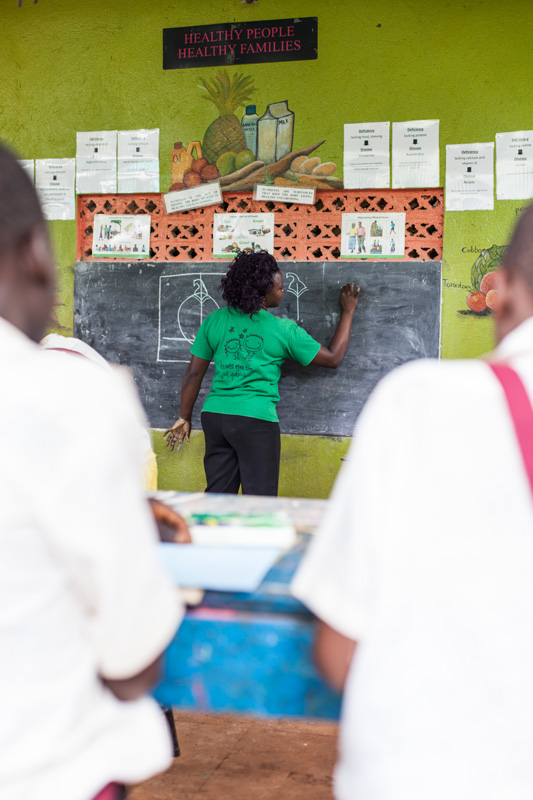
 Our next stop is the kitchen, where SPE uses a fuel efficient stove to cook lunch for the pupils visiting the centre each day. I meet the 4 ladies who cook all the food and they kindly let me take their portraits.
Our next stop is the kitchen, where SPE uses a fuel efficient stove to cook lunch for the pupils visiting the centre each day. I meet the 4 ladies who cook all the food and they kindly let me take their portraits.
In the main centre there is a drama class being run by Fred. He is using a game to teach the children about family planning. In Uganda it is not uncommon for parents to have large families and the average is 7 children. So it is vital that children understand how to manage large families, how much it will cost them and how they would support them. The game allows the children to visually see the implications and what problems they could face. There are 2 groups, each planning the weekly budget for different sized families, each with the same amount of money to spend.
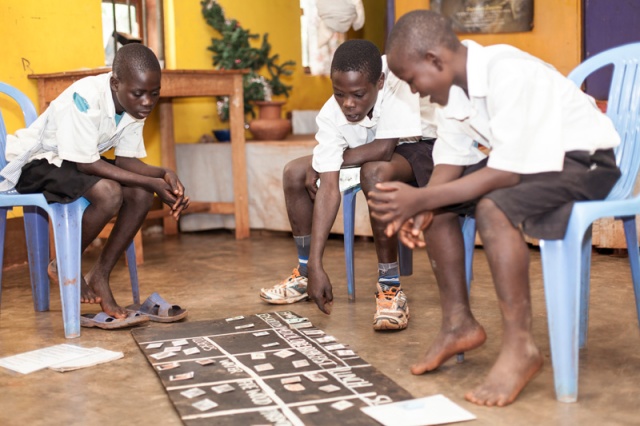 The main building is a flag ship for the charity. It has a tower that can be climbed via a spiral staircase to see the surrounding area. Since being built the surrounding vegetation has all grown up and now all you can see are the tree tops and some nesting birds. However it does offer an additional space where lessons can be held and offers a different perspective of the world.
The main building is a flag ship for the charity. It has a tower that can be climbed via a spiral staircase to see the surrounding area. Since being built the surrounding vegetation has all grown up and now all you can see are the tree tops and some nesting birds. However it does offer an additional space where lessons can be held and offers a different perspective of the world.
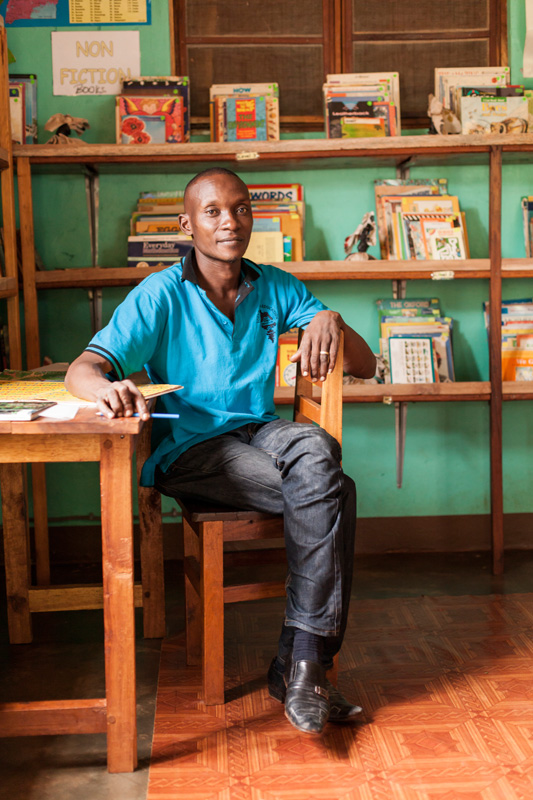 The number of children attending today meant that only 3 classes were running so there are no children in the ICT room. We move on to the library. I am welcomed into the class by the teacher James. He is teaching the children how to use the English dictionary. Although there are many regional dialects, English is the official language of Uganda. The children have been given a list of words, each related to malaria, they need to find them in the dictionary and write down the definitions. This exercise not only helps to learn how dictionaries work, but also educates about the dangers of malaria, its effects, signs and ways to avoid it. All the pupils are intensely studying and for the first time no one really pays me any attention.
The number of children attending today meant that only 3 classes were running so there are no children in the ICT room. We move on to the library. I am welcomed into the class by the teacher James. He is teaching the children how to use the English dictionary. Although there are many regional dialects, English is the official language of Uganda. The children have been given a list of words, each related to malaria, they need to find them in the dictionary and write down the definitions. This exercise not only helps to learn how dictionaries work, but also educates about the dangers of malaria, its effects, signs and ways to avoid it. All the pupils are intensely studying and for the first time no one really pays me any attention.
 We arrive at the AEC office where we meet the staff who keep the centre running and organised. Unfortunately they are dealing with a break-in that happened the night before so I quickly move on. It turns out that someone decided to steal a large collection of knitted items created by one of the community groups that uses the centre. This is sad news as they were going to be sold in a gift shop in Kampala to raise funds.
We arrive at the AEC office where we meet the staff who keep the centre running and organised. Unfortunately they are dealing with a break-in that happened the night before so I quickly move on. It turns out that someone decided to steal a large collection of knitted items created by one of the community groups that uses the centre. This is sad news as they were going to be sold in a gift shop in Kampala to raise funds.
I feel extremely fortunate to have seen this centre. It offers amazing opportunities and support to a wide section of the community. We are only half way into the first day of the trip and I am staggered by the sheer amount of work that Soft Power Education undertakes, and we have barely scratched the surface.
Before coming here I researched the projects I would be visiting, what they do and how they work with the community. Reading about it doesn’t compare to seeing how much effort actually goes into making these facilities run.
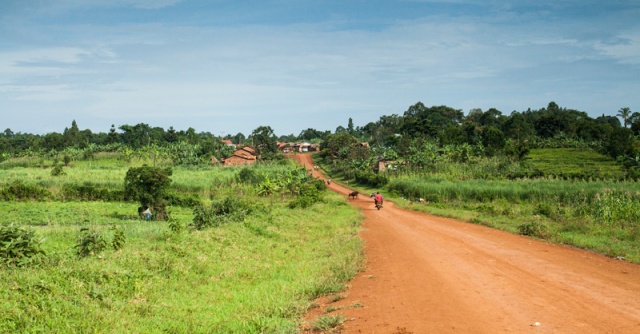 As we drive between the different projects I get the chance to see the communities that benefit by having schools and education centres available to them. Ugandans are proud people. Everywhere we travel people take great pride in their appearance; the men usually in shirts and the women wearing flamboyant dresses and head scarfs. The boda boda riders (motor bike taxis) are regularly seen scrubbing their bikes until they are gleaming. But there is also great poverty. Many people’s only concern is how they will get through the day, selling goods and produce from huts or small shops along the roads.
As we drive between the different projects I get the chance to see the communities that benefit by having schools and education centres available to them. Ugandans are proud people. Everywhere we travel people take great pride in their appearance; the men usually in shirts and the women wearing flamboyant dresses and head scarfs. The boda boda riders (motor bike taxis) are regularly seen scrubbing their bikes until they are gleaming. But there is also great poverty. Many people’s only concern is how they will get through the day, selling goods and produce from huts or small shops along the roads.

I hope you’ve found the second instalment of my trip interesting, and if you would like to help support the charity directly please visit their website here or to help support the book and exhibition please visit my WeFund page here
Thanks for reading and please share.
All photos and text Copyright © Jhy Turley 2014


Pingback: Uganda Trip Diary Part 2- Amagezi Education Centre (AEC), Jinja | It's all about photography